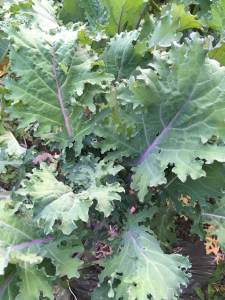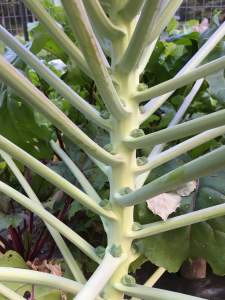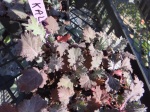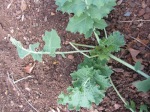This is just a quick post about some instructive cruciferous vegetable (family Brassicaceae) anatomy and within-species diversity apparent in my garden at the moment.
Red Russian kale, rutabagas, and canola oil are all different varieties of Brassica napus. Red Russian kale and rutabagas are in my garden now, and the amplification of leaves and roots, respectively, through domestication is evident.
The rutabaga leaves are large, lobed, and somewhat grayish, like the Russian kale, but they are tougher and not as numerous as on the kale.
You’ll just have to take my word for it that there is no giant rutabaga-like root (technically a swollen hypocotyl, the fused lower stem and taproot, like a turnip, radish, or maca) straining the soil surface on the kale plant.
Anatomical differences amplified through domestication on otherwise vaguely similar-looking cruciferous vegetable plants is also visible on Brussels sprouts and collard greens, two different varieties of Brassica oleracea. A farmer or gardener familiar with the gestalt of the plants will easily identify a Brussels sprouts plant from afar as distinct from a collard greens plant, although the large plant and leaf size are similar.
Up close, though, you’ll see that the larger, more tender collard greens leaves have only a very tiny bud in their leaf axils (where the leaf joins with the stem).
The developing Brussels sprouts, though, are not nearly done growing and are already much larger than the axillary buds in any other variety of B. oleracea.
While red Russian kale is Brassica napus, most of all the other kales are leafy varieties of Brassica oleracea, along with collard greens, Brussels sprouts, cabbage (which is the enlarged terminal bud, similar to the axillary bud), kohlrabi, broccoli, and cauliflower (read about this diversity and more about the anatomy involved in our essay The extraordinary diversity of Brassica oleracea). Last year we let one of the B. oleracea kales, a curly green winterbor variety, overwinter. Many of these brassicas retain the biennial life cylce of their weedy Mediterranean ancestor (read about it in our essay Caterpillars on my crucifers: friends or foes?), so overwintering is something for which a kale plant can prepare itself. The term biennial means that the plant’s life cycle requires two years to complete. In the first year the plant produces a profusion of leaves (the “rosette”). In the second year the plant flowers, sets seed, and dies. The leaves from the first year die over the winter. It is the job of those axillary buds to survive the winter as tightly wrapped bundles of overlapping leaves that will be familiar to Brussels sprouts fans. In the spring those leaves in the axillary buds unfurl and grow as the tiny stem that supports them elongates. This unfurling of leaves from otherwise small axillary buds was apparent this spring in our overwintering kale.

This winterbor kale stem overwintered. Above each leaf scar (from last year) new leaves are expanding on a new lateral stem from the axillary buds.
If you’d like to read even more about cruciferous vegetables in the mustard family (Brassicaceae), we have a few other longer essays that fill in some of this back story:
Thanksgiving turnips and the diversity of the genus Brassica
The most political vegetables: a whirlwind tour of the edible crucifersGreens: why we eat the leaves we do















